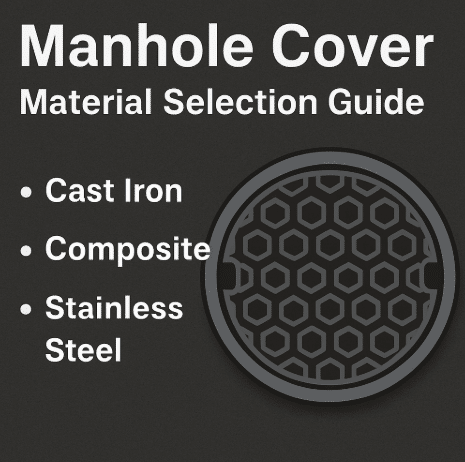Choosing the right manhole cover material is a crucial decision in urban infrastructure and civil engineering projects. The material not only determines the load-bearing capacity, durability, and maintenance costs, but also affects aesthetic appearance and environmental performance.
In modern cities, cast iron, composite, and stainless steel manhole covers are the most commonly used materials. Each material has its advantages and limitations, making it essential to understand their properties before selecting the right one for your project.
Overview of Manhole Cover Materials
Cast Iron Manhole Covers
Cast iron is one of the oldest and most widely used materials for manhole covers. It is known for its strength, durability, and ability to withstand heavy loads, making it ideal for roads, highways, and industrial areas.
Key Advantages:
- High load capacity suitable for heavy traffic.
- Long service life with proper anti-corrosion treatment.
- Stable structure with excellent mechanical performance.
Drawbacks:
- Heavy weight, making installation and maintenance more difficult.
- Prone to rust without protective coating.
- Theft risk, as iron can be resold as scrap metal.
Best Applications: urban roads, industrial zones, airports, and logistics areas.
Composite Manhole Covers
Composite materials are increasingly popular due to their lightweight nature, non-metallic composition, and corrosion resistance. Typically made from fiber-reinforced polymer (FRP) or resin composites, these covers combine strength with aesthetic flexibility.
Key Advantages:
- Lightweight and easy to install manually.
- Non-conductive and corrosion-resistant for chemical and coastal environments.
- Customizable appearance, color, and logo options.
- Zero scrap value, minimizing theft.
Drawbacks:
- Limited load-bearing capacity compared to cast iron.
- More expensive for high-strength versions.
- Sensitive to UV radiation if not treated with protective coatings.
Best Applications: parks, pedestrian zones, villas, residential communities, and utility areas.
Stainless Steel Manhole Covers
Stainless steel covers are known for their modern appearance and superior corrosion resistance. They are widely used in commercial buildings, kitchens, swimming pools, and public sanitation systems.
Key Advantages:
- High corrosion and oxidation resistance.
- Excellent aesthetic appearance with a clean, modern finish.
- Lightweight and easy to clean.
- Long service life with minimal maintenance.
Drawbacks:
- Not suitable for heavy traffic (less load capacity than cast iron).
- Higher initial cost.
- Can be slippery without anti-slip surface treatment.
Best Applications: indoor drainage, bathrooms, swimming pools, commercial areas, and parking facilities.
Comparative Analysis of Materials
| Feature / Material | Cast Iron | Composite | Stainless Steel |
|---|---|---|---|
| Weight | Heavy | Light | Light |
| Load Capacity | Very High | Medium | Low to Medium |
| Corrosion Resistance | Medium | High | Very High |
| Theft Risk | High | None | Low |
| Maintenance Needs | Moderate | Low | Very Low |
| Cost | Medium | Medium to High | High |
| Aesthetic Value | Industrial | Customizable | Modern and Elegant |
Environmental and Safety Considerations
Sustainability
Composite and stainless-steel covers offer environmental advantages over cast iron.
- Composite materials can be recycled or manufactured with eco-friendly resins.
- Stainless steel is 100% recyclable and leaves no toxic residue.
- Cast iron, though recyclable, requires high-energy smelting processes that contribute to CO₂ emissions.
Safety and Anti-Theft Design
Modern composite covers use lockable and hinged designs, improving safety for pedestrians and vehicles. Stainless steel covers are often integrated with anti-slip textures and water-seal structures, preventing accidents and contamination.
Choosing the Right Manhole Cover for Your Project
When selecting a manhole cover, several factors must be considered beyond just material type:
- Load Requirement:
- Heavy traffic → Cast iron
- Medium load areas → Composite
- Light load/indoor → Stainless steel
- Environmental Conditions:
- Coastal or chemical areas → Composite or Stainless steel
- Industrial or highway areas → Cast iron
- Budget and Maintenance:
- Limited maintenance resources → Composite
- High-end projects → Stainless steel
- Cost-effective, long-term use → Cast iron
- Aesthetic Integration:
- Public spaces or plazas → Composite (custom colors and logos)
- Modern architecture → Stainless steel
Engineering Adaptation and Customization Options
Custom Sizes and Shapes
Manufacturers now offer customized shapes (round, square, rectangular) to fit diverse construction designs. CAD-assisted design ensures exact matching with drainage systems.
Logo and Branding Options
Composite and stainless steel covers allow engraved or printed logos, useful for municipalities or private contractors to strengthen brand identity.
Integrated Frames and Seals
Modern designs include integrated rubber seals for waterproof performance and hinged frames for easy access during maintenance.
Maintenance and Lifecycle Management
Proper maintenance ensures longevity regardless of material type:
- Regular inspection for cracks, corrosion, or deformation.
- Surface cleaning to avoid debris accumulation.
- Anti-rust treatment for cast iron covers.
- UV protection coating for composite materials.
Implementing a scheduled maintenance plan significantly reduces replacement costs and enhances overall safety.
Conclusion
The right manhole cover material depends on your project’s technical and environmental requirements.
- Cast iron offers unmatched strength for industrial and traffic-heavy zones.
- Composite provides corrosion resistance and safety for public and residential environments.
- Stainless steel adds elegance and hygiene for commercial and indoor applications.
In essence, the material selection defines the longevity, safety, and efficiency of your drainage and access systems. Collaborating with a professional manhole cover manufacturer ensures optimal design and compliance with international standards.
FAQ
Q1: Which manhole cover is best for coastal environments?
A: Composite or stainless steel covers perform best due to high corrosion resistance and low maintenance requirements.
Q2: How long do cast iron manhole covers last?
A: With proper coating and maintenance, cast iron covers can last over 30 years in urban conditions.
Q3: Can I customize the logo or color of a manhole cover?
A: Yes. Most composite and stainless steel covers support logo engraving, branding, and custom color finishes.
Q4: Are composite manhole covers safe for road traffic?
A: Standard composite covers are suitable for light to medium loads, but heavy-duty versions are available for road use.
Q5: How do I choose a reliable manhole cover manufacturer?
A: Look for a supplier with ISO certification, customization services, and experience in municipal or construction projects, such as Xinghua Castings.





